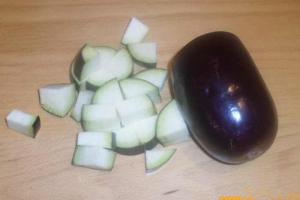Shown simple mousetrap from a PET bottle, but, unfortunately, some rodents can escape from it. Several modifications are proposed to improve reliability.
1.Installing the lid on the mousetrap
The mousetrap is made from two identical bottles with a capacity of 1.5-2 liters. For the first bottle, only part of the conical part is cut off, and for the second bottle, the conical part is completely cut off. The conical part of the second bottle will be the lid of the trap.
We make two symmetrical holes on the edges of the conical part of the first bottle for attaching a fishing line and hanging a bottle overturned by a rodent on this fishing line. We attach the cap to the top of the first bottle and mark the centers of two holes with a diameter of 5-7 mm coinciding with the centers of the exit holes of the suspension lines. We make holes in the lid. With our own hands we pass the fishing line through the holes in the lid and tie it to the first bottle.
Organizing the removal of the lid from the table
Refinement of the mousetrap
If you install the mousetrap in this form, then when it tips over, the lid will not close the bottle in any way and will most likely remain on the table. A special pusher is required to move the cap behind the bottle. The pusher is made of wire in the shape of a cut letter “P”; the width of the upper shelf should be equal to the distance between the holes for attaching the fishing line. We firmly wrap the pusher at a distance of ~20 cm from the bottle to the fastening lines. When the bottle falls down, the cap placed between the pusher and the bottle will be thrown off the table by the pusher. At the same time, the pusher will optimally straighten the fishing lines for proper lowering of the cap onto the bottle.
The operation of the mousetrap is shown in the video.
You can simplify your homemade project by eliminating the pusher, but to do this you will have to organize the bottle to be suspended outside the plane of the table.
2. Increasing the length of the bottle
We take a plastic PET bottle and cut off a section of the conical part, immediately making a hole in the bottom for the mouse to enter. From the first revision there was a bottle without a neck. We combine the bottles together, try to achieve a tight connection and wrap the joint with tape to secure the fastening. The result was a bottle of increased length, and even with an additional obstacle from the conical part. We tie the bottle, put the bait at the bottom and set it up for fishing.
Tests of such a homemade mousetrap are shown in the video.
Surely a good design will come from two bottles with cut off bottoms and one neck. The bottles are combined and also connected with tape; the presence of a conical bottom when tipping over will further complicate the rodent’s precise jump to freedom.
An elongated bottle allows you to move the battlefield from buildings to the surrounding area. We bury the combined bottles under the hole for the rodent's entry vertically into the ground (be careful so that the structure does not collapse under the weight of the earth). We put bait inside. We regularly check the results and, if necessary, reinstall such mousetraps.
The topic of constructing mousetraps is very interesting and will be continued.
In the future, we will publish a simple, reliable and very sensitive office floor mousetrap and an automatic reusable mousetrap made from PET bottles.
More material on the topic of mousetraps.
Terms homemade mousetrap...
To get started, I suggest you watch a video on this homemade product:
Some people complain that they hear an incomprehensible grinding noise in their home... There are many reasons for this, one of which is that you have mice in your home!!! Many people are afraid of mice and therefore do not know how to catch them... Of course, there are many different types mousetraps, but most of them kill the mouse... And if you don't want to kill or just want to catch a live mouse and keep it as a trophy, then this article is just for you... In this article I will tell you how you can do make your own homemade mousetrap at home, with the help of which you can catch a mouse, while it will remain alive and unharmed...
So, let's begin...
For our future mousetrap we will need:
- multi-liter bottle (bottle) for 5-6 liters;
- knife (scissors);
- bait (for example, a piece of cheese);
- a piece of wire;
- paper clip;
- a counterweight or weight (a washer or a piece of eraser)...
So first you need a lot liter bottle cut into three parts as shown in the photo...

We do not cut out the middle part of the bottle exactly, but leave such a “tail” and fix a piece of wire on it... We bend the tail at an angle of 90 degrees...




We attach mouse bait (for example, a piece of cheese) to the tip of the cut out shape...

Now we turn the middle part of our cut boklag over and carefully place it in the lower part of the boklag...

Next, we carefully attach the shape we cut out to the rest of the mousetrap as shown in the photo... (We bend the “ears” of the shape and secure them with a wire axle...) We got something like a swing...

Now our swing needs to be balanced... To do this, attach a paper clip to one end of the form and add a weight until the “swing” is balanced...

You need to stretch, for example, a piece of cardboard from the surface to the top of the eggplant... This is done to make it easier for the mouse to get to the bait and get into the mousetrap...
That's all!!! Our mousetrap is ready...
Now I will explain how it works...
The mouse, seeing the cheese, will want to get it and will climb up the cardboard box, step on the “swing” and fall to the very bottom of the eggplant, after which it will not be able to get out of the eggplant on its own...
Rodents can take up residence in a room where food is occasionally available. The consequences of such a neighborhood are disappointing. In addition to irritation and anxiety, mice are carriers of infections and active pests of food and furniture in the home. The solution to the problem can be a do-it-yourself mousetrap made from improvised materials. Below is a rating of the most effective trap options that you can make yourself.
What are the advantages of mousetraps made from scrap materials?
Before considering the features of mousetraps from the top, a few comments regarding their advantages over ready-made traps or such fashionable devices as an electronic mousetrap for exterminating rodents.
If we compare traps made at home with drugs used to bait rodents, the former will turn out to be more humane and safe. You can catch uninvited guests using homemade boxes, buckets and bottles at any time, without requiring the removal of household members from the house. But insecticides do not allow for the presence of children and pets in the house, which creates certain difficulties.
Undeniable advantage homemade trap for rodents - availability of funds. You can make a mouse trap from anything without extra costs, starting from cardboard box from under the cake and ending with a plastic bottle.
An important advantage of homemade mousetraps is their reusability. Besides, most of traps work in such a way that they do not require constant monitoring.
Secrets of choosing the right bait
You can make a mousetrap that will be thought out to the smallest detail, designed to reusable in automatic mode, but only the right bait will help achieve the effect.
It is believed that rats and mice are crazy about cheese. This is actually a stereotype. Indeed, the product does not leave the animals indifferent, but it is not their favorite treat. Rodents are much more interested in bulk baits with a pungent odor, for example, bait made from:
- sunflower seeds;
- bread crust dipped in sunflower oil;
- breadcrumbs in sesame oil;
- lard and blood sausage.
All these products will attract the attention of rodents, which means they will lure them into pre-prepared traps.

How to make a wood trap at home?
The desire to make a trap for mice or rats with your own hands and using available materials is completely justified in all respects. Using previously unnecessary materials(remains from repairs or construction work), you can build really working devices for catching pests.
Wooden mousetraps are one of the most practical options. Such devices can be used for a lifetime, exterminating more than one generation of rodents. On initial stage It's worth trying to make a 5-cell trap. For this, a small piece of timber with parameters 180×100×60 mm from any wood, two pieces of steel wire with a diameter of 2 mm and 0.2 mm, as well as natural thread No. 30 are suitable.
The manufacturing process begins with preparing holes in the wooden base of the device. In total, you will need 35 such holes with a diameter of 1 mm each. The next step is to drill 5 niches with a diameter of 30 mm and a depth of 65 mm. The device will require staples and springs - they are made from prepared parts of wire. As soon as the springs are fixed to the base, nooses made of thin wire are attached with a margin of 15 mm.

The finished mousetrap is charged using a thread. It is threaded into a large needle, the spring is pressed and tied with several knots. The remaining cells are prepared in the same way. Once all the compartments are charged, prepare the bait. These mouse traps work by simple principle. The rodents smell the bait, chew the thread to get to it, and the spring with the noose is triggered.
Jar and paper - how does the trap work?
A simple option is a mousetrap from a jar, which even a child can make. So that rodents can climb to the neck of the jar, a kind of “ramp” is built for them, and the bait is placed inside the jar, tightening the neck with paper cut crosswise.
As soon as the mouse touches the paper, its parts will open and the victim will fall into the container. This humane mousetrap is suitable for those who are not ready to take on the responsibility of exterminating mice. It has a significant drawback - low level efficiency. Often mice, especially those with experience, sense a catch and do not touch the cut paper. Only young individuals who are unable to sense danger in advance get into the jar.

A jar and a coin - how to make a mousetrap?
Another version of the device for catching mice from a jar, this time with a button or coin. Just like the previous option, the can will not kill, but will only help catch rodents in a humane way.
The operating principle is more than simple. A button, coin or any washer is used as a support, lifting the jar (can be replaced with a pan or bucket). A strong thread with a hook is tied to the support, a rod is placed inside the container to secure the thread, and bait is placed on the hook. The smell of the treat will attract the mouse to the jar, it will pull the hook, the thread will stretch and drop the washer as a support, as a result of which the rodent will be trapped unharmed.

Using the same principle, a trap can be made from a box, for example, from under a cake. A hole is made in the lid exactly in the middle, where half of the stick with a cotton swab at the end is inserted so that it is outside, and the part without the swab is inside the box with the bait.
Any weight can be placed on the lid of the box; it can prevent the mouse from trying to get out after the trap slams shut. The bait is attached to a stick inside the box, the edge of the lid is lifted and placed on a small support. The rodent will be attracted by the smell of the bait, it will climb into the box, and when it tries to remove the food from the stick, the box with the weight on the lid will close.
Such homemade mousetraps are quite effective, but have one significant drawback - they work once, which means they can catch one mouse.
Bucket of water at the base of the trap - device
A working mousetrap from a bucket of water is easy and quick to make. To do this, two holes are drilled in the bucket, a metal rod is passed through them with a plastic bottle previously placed on it with a lid lubricated with oil for easy rotation.
The neck of the bottle is pulled to the edge of the bucket, and bait is attached to the middle. The mouse, sensing the smell of food, will climb up the bottle, will not be able to stay on the slippery surface and will fall into the water.
Simple and yet effective designs of mousetraps of this type allow you to catch several individuals at once in the absence of the owners of the house.

A simple mousetrap from a flower pot - the secret of the device
Ownerless flower pots can be used around the house. One of them is a DIY mouse trap. The primitive and at the same time effective device of a mousetrap allows you to catch rodents in a short time without much difficulty and expense. It works simply: the pot is turned upside down, placed at an angle on a small “guard” by analogy with the jar described above.
The bait is placed on the end of the “guard”. As soon as the rodent smells the bait, it will try to remove it from the tip, which will lead to the pot falling and the trap slamming shut. To prevent the prisoner from escaping, it makes sense to install such traps on sheets of plywood that prevent digging.
Glue mousetraps - how do they work?
Glue traps are also quite easy to make with your own hands, using mouse glue, a base such as plywood or a plastic tray, and of course bait.
The base is coated special glue for mice (just buy in a specialized store), a trap is placed in the center. There is nothing complicated about how this type of mousetrap works: a mouse or rat will get close to the treat and stick to the composition of the tray.
The disadvantage of the trap is that it is not the most humane method of capture. The rodent, sticking to the base, does not die, but for a long time tries to free itself, desperately squeaks and squirms, at the same time, it is no longer possible to peel it off. For those who find it difficult to endure the suffering of animals, an option such as homemade Velcro for mice will seem inappropriate.

A simple trap made of plastic containers - manufacturing algorithm
A more than simple, and most importantly humane way to catch rodents at home is to make a trap from a plastic container. To do this you will need the following elements:
- plastic bottle;
- thread or rope;
- bait.
A mousetrap is being built from plastic bottle Just. Cut off the neck of the container and make two holes for attaching the thread. In inner part they put bait. One part of the thread is tied to a weight or glued to the edge of the table. The container is placed on the table so that most of it hangs from it.
As soon as the mouse comes to the scent of the bait, it will climb into the bottle and gravity will play a role here - the bottle will fall to the floor along with the rodent, hovering above the floor due to the correctly selected length of the thread. The caught prey can be released away from the house without stress for it and the household.

Top mousetrap - how does it work?
Effective traps for mice at home, also suitable for catching rats - “tops”. Visually, these are structures based on elongated cells with a cone-shaped entrance. At the level of the cut end of the structure, another entrance begins - this is a dead end. Its lower part is the bottom made of a smooth plate, fixed wide base. The plate is pressed against the cone underneath and acts as a counterweight to mask the stroke.
A rat or mouse will try to get inside based on the smell of the bait. When unsuccessful, she will try to move back to make sure the exit is safe, after which she will go inside again and hit the second cone. Under the weight of the animal, the platform will lower and the victim will fall to the bottom of the trap, after which the structure will be restored to working condition for new prey. You can make a design with your own hands if you have finished drawing traps.

Zürner mousetrap - how to make it at home?
A design similar to the previous one is a Zürner trap at the base with a box, which is masked on the outside with a sloping lid and lined with galvanized iron on the inside. Two opposite sides have inlet holes or windows; opposite each there is a fixed bridge on a hinge, the ends of which rest on the edges of the holes. The inner ends are unsupported and form long bridge, stretched “over the abyss.” A hook with bait is attached above the area where the bridges close, fixing it on the lid of the box.
The design works according to the following principle:
- the mouse runs along the bridge to the bait;
- under its weight the bridge bends and the animal falls to the bottom;
- the bridge returns to its original position.
Is it possible to make a trap at home with such a device? This is possible, and the process of constructing the structure will be many times simpler than the process of constructing the previous “top” mousetrap.
Small animals become a nuisance for owners of gardens and dachas, and residents of private houses often suffer from their invasion. Spoiled crops and products are not the main problem. Rodents, as carriers of serious diseases, can infect humans with them. It is not difficult to make homemade mousetraps from scrap materials.
DIY mousetrap - advantages
It is easy to purchase a device for catching mice, but the factory mechanism with a metal spring is not humane, especially if a child sees the bloody result of the work. The disadvantage of such a mousetrap is its high cost. Poisoning rodents with chemicals is dangerous if there are other animals at home. In such a situation, it is more convenient to make a mouse trap with your own hands.
Homemade designs much cheaper. They are made from any materials that every home has and you don’t mind throwing them away, which saves money. Advantages of a DIY mousetrap:
- ease of execution;
- the design does not deprive the mouse of life, but limits freedom;
- does not require much time to manufacture;
- mice are not familiar with the new device and do not know how to avoid danger;
- if it breaks, another trap is quickly made;
- safety for children and pets;
- work allows you to demonstrate your skills to loved ones.
Types of mousetraps
You can make reusable homemade mousetraps with your own hands, which are constructed from a glass jar or plastic bottle. The animal will remain alive, the mouse can be released outside or into the forest, and the trap can be used again. Disposable mousetraps are made from glass bottle with a wide neck where the animal gets caught and cannot get out. To release the mouse, the trap must be broken.
You can make various types of mousetraps with your hands:
- using plastic bottles;
- a structure made of a bucket of water into which a mouse can fall;
- a cardboard trap with specially applied sticky glue for rodents;
- bottle mousetrap or glass jar;
- slamming design made from a pan or vessel of suitable volume;
- device made of wood or metal;
- a mousetrap-abyss where an animal falls from a height into a bucket;
- electronic trap.
How does a mousetrap work?
Do-it-yourself traps for rodents have different schemes devices. How does a mousetrap work? The action of the trap is based on the principle:
- displacement of the center of gravity - a bucket of water;
- slamming - glass jar, cake box;
- spring actuation - wooden structure;
- gluing to a lubricated surface;
- changes in circuit resistance - electronic mousetrap;
- inability to get out of a tall container - a jar with a paper lid;
- getting stuck in a plastic bottle with sharp petals.
Mouse bait in a mousetrap
You can lure an animal into a trap you made yourself by placing bait in a mousetrap. There is a persistent misconception that mice love cheese. Numerous experiments have led to the conclusion that this product is not considered a priority among them. It should be noted that rodents love fresh and high-quality food; they will pass by a mousetrap if they doubt that the products are harmless. It is necessary to lubricate the device with oil or alcohol to remove human odor.
It is preferable to choose products with a strong aroma and soak them in sunflower or sesame oil. The best bait for mice in a mousetrap:
- smoked or salted lard - can be fried with a match;
- sunflower oil, preferably unrefined;
- a piece of fragrant bread, preferably fresh;
- sunflower seeds;
- pizza slices;
- buckwheat, wheat, rice seeds;
- smoked sausage;
- nuts;
- fresh or boiled meat.

How to make a mousetrap
To make a mouse trap with your own hands, you must first decide on the design, select necessary materials. You can make a mousetrap using:
- unnecessary bucket or container;
- plastic bottle;
- glass jar;
- plastic and paper;
- cake box with cotton swabs and soap for weight;
- wooden blocks;
- cell and electronic circuit.
DIY mousetrap from a plastic bottle
Craftsmen create miracles from this everyday item. A mousetrap made from a plastic bottle, which is easy to make with your own hands, was no exception. Once a mouse gets there, it cannot get out; it will remain there until it is thrown out. One of the manufacturing options:
- take the bottle;
- separate half of it;
- on the part where the bottom is, make cuts with scissors about 2 cm long, equal to 1/2 the diameter of the circle;
- sharpen each petal;
- bend it inside the bottle;
- put bait on the bottom;
- the mouse will go inside, and the sharp teeth of the petals will prevent it from coming back out.
A do-it-yourself mousetrap from a plastic bottle is made in another way using this method: step by step instructions:
- cut the container in half;
- shorten the neck so that a mouse can easily pass through it;
- grease the inside with oil;
- put bait on the bottom;
- insert the upper part inside the lower part with the neck down;
- The mouse rushes for food, falls into the bottle, and cannot get out.
There is another effective option for quick DIY production - a mousetrap that works without misfires:
- cut off the end of the bottle at the narrowing point;
- make a hole and tie a rope to it;
- put bait inside;
- place the bottle on the edge of the table surface - most of it should hang down;
- tie the free end of the rope or glue it with tape so that when it falls, the container does not reach the floor;
- the mouse, penetrating inside, moves the center of gravity;
- the bottle hangs with the rodent.

Mousetrap made from a bucket of water
You can use an old bucket as a mouse trap. To implement the idea you need:
- drill 2 holes on top;
- pass a metal rod horizontally through them;
- put an empty bottle with a lid, lubricated with oil, on it - the container should rotate freely around its axis;
- move the neck of the container to the edge of the bucket;
- the mouse, sensing the smell, will climb to the bottle;
- it will turn and the animal will fall into the water.
You can also consider the option of using a bucket to make a trap with your own hands; liquid is poured into one third of the volume. A mousetrap from a bucket of water is made like this:
- on top of the container, not far from the edge, a knitting needle is secured horizontally with insulating tape;
- a ruler or strip is glued to it at an angle of 90 degrees, one end rests on the edge of the bucket, and the other hangs freely;
- bait is placed on it;
- a block is placed on the side of the bucket at an angle;
- the mouse climbs along it to the bait;
- the free end of the ruler tips over under the weight;
- the trap is triggered.
A very simple disposable mousetrap to make with your own hands, made from a calendar similar in shape to a house. In this situation, the bucket is placed on the floor near the edge of the table. The mousetrap is made according to the principle of shifting the center of gravity:
- the calendar is installed on the plane of the tabletop so that the edge extends halfway beyond the end;
- delicious food is placed at the far end;
- the mouse goes to the bait;
- the house tips over into the bucket along with her.
DIY mousetrap made of wood
For those who cannot regularly come to the dacha to check whether someone has fallen into a trap or not, you can make a multi-seat structure. In this case, a do-it-yourself wooden mousetrap is made at once to catch several rodents, for example, six. For production you will need:
- wooden block 4x10 cm, length 40 cm;
- bicycle spokes – 6 pieces;
- thin wire;
- strong thread.
The process of building a mousetrap is as follows:
- at the end of the block, drill holes with a diameter of 2 cm and a depth of 1 cm - these are minks;
- retreat from the edge on the same side 10 mm;
- make a longitudinal cut to the bottom of the holes;
- move the line from it by 2 cm;
- drill two holes with a diameter of 2 mm perpendicular to the hole;
- use the same drill to perform another one on the same plane, closer to the other edge;
- roll a spring from a knitting needle;
- Attach a wire loop at the end.
Assemble the mousetrap in the following sequence:
- insert the free end of the spring into the hole on the plane;
- hide the loop in the cut so that it coincides with the outline of the mink;
- pass the thread through 2 small holes and fix the spring;
- put bait deep into the hole;
- the mouse, wanting to have a tasty morsel, chews the threads;
- the spring is triggered, only the tail sticks out of the hole, which does not frighten other animals that fall into neighboring holes.

Mousetrap from a jar
A very simple option for making a trap with your own hands from a glass jar, which must first be rinsed well. To make a mousetrap:
- make a paper cover on top;
- secure with masking tape or twine;
- make two perpendicular cuts with a sharp knife;
- the bait is suspended above the jar;
- the mouse will want to eat it, stand on the paper and fall through.
A mousetrap from a jar can be made in another way, which requires a coin. Important condition– necessary large diameter, for example, 5 rubles. For the convenience of subsequent removal of the mouse, the entire structure must be placed on a base - a sheet of cardboard. The mousetrap is made like this:
- a piece of lard is attached with double-sided tape;
- fixed on back wall from the inside;
- the opposite end rises;
- a coin is placed on its edge under it as a support;
- the mouse, trying to eat the bait, touches the jar;
- the coin falls, the mousetrap slams;
- the animal will not be able to get out.
DIY electronic mousetrap
For those who understand electronics, it will not be difficult to make a mousetrap according to the diagram shown in the photo. The design consists of a cage, on one side of which a gate valve is installed on vertical runners. At the top of the device, near the entrance, there is an electromagnet, the armature of which is spring-loaded towards the gate, and the tip is pointed. 2 holes are drilled on the damper opposite the anchor;
- when the gate is fully raised, the tip enters the lower hole;
- when lowered, due to the spring, it enters the upper position.
A DIY electronic mousetrap can be made by a passionate person. A pointed electrode is provided in the far corner of the structure. It has a tasty bait attached to it. The electrode and magnet are connected to an electronic circuit. The mousetrap works like this:
- the gate rises to the top position, where it is automatically fixed by a spring;
- the mouse enters the cage;
- hits the bait.
- when the mouse touches the bait, the resistance in the circuit quickly changes;
- the electromagnet is connected to a storage capacitor;
- the gate lowers, closing the entrance;
- the electromagnet armature fixes the damper at the bottom;
- turns on sound alarm, warning the owner about the appearance of an unexpected guest in the cage.
Video: DIY mouse traps
For many centuries, small rodents have lived side by side with people. Despite the fact that this neighborhood is very profitable for the latter, people come up with various devices to catch these uninvited guests.
Can also be used chemicals to get rid of mice, but their use in the house is not always justified, since they harm not only rodents, but also pets and apartment owners.
There are spring mousetraps on sale, but their disadvantage is that they require “recharging,” which is not always convenient. And the sound of a slamming mechanism, especially at night, can be quite frightening. And besides, these mousetraps are not humane.
There are many options for making mousetraps with your own hands. Let's look at the most popular of them.
DIY mousetraps from a plastic bottle

There are already enough options for mousetraps made from plastic bottles. a large number of. Their production does not require much time or any Additional materials. These traps are a humane way to deal with gray tenants. Once caught, they can be taken somewhere away from home and released.
The simplest mousetraps made from a plastic bottle:
Take a regular 1.5 - 2 liter bottle without a cap and pour a little oil into it, in which something was fried. You also need to lubricate the neck of the container. Place the bottle itself at an angle with the neck up on a board or some other improvised means and hold it on the sides so it doesn't fall. Once a mouse gets into a bottle and wets its paws in oil, it will slide along the walls, but will not get out.
Place a plastic bottle with an open neck and bait inside on the edge flat surface(for example, on a table) so that half of the bottle at the bottom is unsupported. There, at the bottom, there should be bait. At the same time, tie the neck of the bottle to something so that when the trap is triggered, it does not fall to the floor, but remains hanging. The mouse, sensing the bait, will climb into the mousetrap through the neck or a hole specially cut at the top, approach the bait, the bottle will lose its balance and hang with the captive inside on the rope.
With this method of catching mice, one must take into account their ability to jump well. There is a possibility that a series of jumps will end in success, and the slave will “jump” to freedom.
With this method of making a trap, you will need a sharp knife and a plastic bottle. You need to cut off its upper tapering part. On the bottle itself, make cuts in the form of petals, which then carefully bend inward. Throw a piece of lard, cheese, bread or other treat for mice to the bottom and place the resulting trap in the rodents’ habitat.
Having smelled the food, the mouse will be able to climb into the bottle, but will not be able to get back out. Sharp “petals” will not allow her to get out.
But there are also more ingenious mousetraps, made with your own hands from a plastic bottle.
Instructions on how to make a mousetrap from a plastic bottle with your own hands
To make a more “advanced” trap from a plastic bottle with your own hands, you need the following components:
Plastic bottle
sharp scissors or knife
2 sticks made of wood or other material
2 rubber bands
paper clip
rope
Step by step guide
1. Cut 1/3 of the bottle at the top, but not all the way, but to create a rising structure.
2. Make 2 holes on the sides of the top of the bottle opposite each other, and insert a stick through them so that its ends stick out.
3. Do the same with the bottom of the bottle.
4. Fasten the rope to the neck of the bottle, pulling it so that the upper notched part of the container rises up from a horizontal position, that is, the trap opens.
5. Connect the sticks with rubber bands on both sides of the bottle.
6. Make a hole in the bottom of the bottle and stick a straightened paper clip into it. Attach a rope from the neck of the bottle to the paper clips on the outside in a taut state, and inside the bottle attach a bait to the paper clip that will fix
rope.
7. Place the made trap horizontally in the open state.
By getting into the trap and removing the bait from the paperclip, the mouse activates a mechanism in which the paperclip flies out, the tension is broken and the trap slams shut.
DIY mouse trap at home
You can make a device for catching rodents with your own hands, not only from a plastic bottle. There are many improvised means in the house that, if necessary, can be turned into a mouse trap.
Conventionally, mousetraps can be divided into 2 types:
1. Humane. When used, mice remain alive.
2. Destructive action. In this case, the animals die.
What to make a mousetrap from?
A very simple trap can be made from an upside down jar (glass or tin), a saucepan, or even a cake lid.
First, using tape, you need to attach the bait to the wall of the container as high as possible. Place the inverted container on flat surface, and raise one edge and support it with a washer, coin, or button placed on the edge.
A mouse can easily crawl inside the trap and, while getting food, will disturb the balance of the structure, the support will fall, and the animal will be trapped.
It should be noted that the container should be quite heavy, so if necessary, you need to put a load on top of it.
Even a chessboard can be used in this way. To do this, you need to put it on one sash, and open the other slightly, securing it with something unstable. The animal will easily crawl inside and, taking out the bait, will upset the balance, and the doors will slam shut.
Mousetrap made from a bucket of water
You can also use a bucket as a mousetrap. If you feel sorry for the mice, you don’t have to pour water into it, but in this case escape is possible. If the war is already merciless and without prisoners, then water is necessary.
You can make several types of traps with your own hands using a bucket.
For example, place a bucket at the edge of a table or other surface, and place a ruler with bait on the edge of the table. The animal will go for food, overweight and fall into the bucket. You can only catch one mouse this way.
1. Pour water into a bucket, and loosely cover it with a lid so that when you press the edge of the lid, it turns over. Glue the bait with tape. The rodent, taking out the treat, will turn over and end up inside, and the lid will return to its original position.
2. Tin can or place a plastic bottle on the rod so that it rotates freely around its axis. Place the rod itself or secure it in the upper part of a bucket of water. Attach a treat for the mouse to the jar using tape or glue. Attach a board to the bucket for a more comfortable trip. Having reached the edge of the bucket, the mice go to the bait, the rod turns over, and the mice fall into the water.
Electronic mousetrap
If you have sufficient funds, you can buy an electronic mousetrap, which provides guaranteed and, to some extent, humane destruction of rodents.
The same products are used as bait here as in a regular mousetrap. The mouse, attracted by the smell of food, falls into a trap and is no longer able to get out. In a trap, the rodent dies instantly from an electric shock.
Craftsmen who understand electrical circuits can make a similar mousetrap with their own hands by finding diagrams on the Internet or coming up with their own version of a trap.
What to put in a mousetrap as bait
Mice are omnivorous pests. You need to hide all the food in the house from them. But in order to catch them in a short time, you need to use your favorite mouse treats as bait.
- 1. Lard. Mice love the smell of lard (especially smoked lard). Even a small piece is enough for the mouse to smell it and come running to the smell.
- 2. Sunflower oil. Mice love unrefined oil, and if something was also being fried on it, then mice from all corners of the house will come running to this smell.
- 3. White bread. And with sunflower oil it’s even better.
- 4. Seeds and peanuts. Be sure to be fried, in this case only 3-4 pieces are enough.
- 5. Sausage, preferably smoked. It is more oily and smelly.
Contrary to popular belief, mice are calm about cheese. You can use it as bait if there is nothing else tasty.
If there are a lot of mice in the house, you need to change the bait and choose your favorite products. Or put different food in several mousetraps.
Mice have long and firmly established themselves next to people both in private houses and in high-rise apartments, especially with garbage chutes. And entire colonies of rodents live in basements with communications, from where they spread throughout the house.
But, if you tirelessly use all your knowledge and skills in the field of fighting gray animals, then it is quite possible to defend your home. Mice are cunning and tenacious pests, but man is still the “crown of nature,” which means that with a certain persistence, victory will be his.
How to charge a mousetrap without getting hurt?
In the heat of the hunt, you should not forget about your own safety. To effectively install a mousetrap so that it performs its function, precautions must be taken.
When installing a purchased spring mousetrap, you must perform the following steps:
first put the bait on the trigger;
After this, carefully cock the clamp;
then place the holder on the clamp;
insert the holder into the trigger.
You should also charge homemade mousetraps very carefully. For example, a trap made from a plastic bottle with curved “petals” must be infested before the petals are bent, otherwise there is a risk of getting hurt on the sharp edges.








